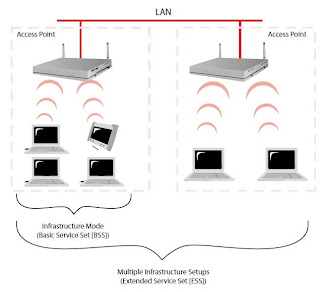The 802.11 specification defines two types of operational modes: ad hoc (peer-to-peer) mode and infrastructure mode. In ad hoc mode, the wireless network is relatively simple and consists of 802.11 network interface cards (NICs). The networked computers communicate directly with one another without the use of an access point. In infrastructure mode, the wireless network is composed of a wireless access point(s) and 802.11 network interface cards (NICs). The access point acts as a base station in an 802.11 network and all communications from all of the wireless clients go through the access point. The access point also provides for increased wireless range, growth of the number of wireless users, and additional network security.
Ad Hoc Mode
In ad hoc mode, also known as Independent Basic Service Set (IBSS) or peer-to-peer mode, all of the computers and workstations connected with a wireless NIC card can communicate with each other via radio waves without an access point. Ad hoc mode is convenient for quickly setting up a wireless network in a meeting room, hotel conference center, or anywhere else sufficient wired infrastructure does not exist.
Infrastructure Mode
In infrastructure mode, all mobile and wireless client devices and computers communicate with the access point, which provides the connection from the wireless radio frequency world to the hard-wired LAN world. The access point performs the conversion of 802.11 packets to 802.3 Ethernet LAN packets. Data packets
traveling from the LAN to a wireless client are converted by the access point into radio signals and transmitted out into the environment. All wireless clients and devices within range can receive the packets, but only those clients with the appropriate destination address will receive and process the packets.
A basic wireless infrastructure with a single access point is called a Basic Service Set (BSS). When more than one access point is connected to a network to form a single sub-network, it is called an Extended Service Set (ESS).
The 802.11 specification includes roaming capabilities that allow a client computer to roam among multiple access points on different channels. Thus, roaming client computers with weak signals can associate themselves with other access points with stronger signals. Alternately, by setting up multiple access points
to cover the same geographic area and by using different non-overlapping frequencies, client workstation networking loads can be better balanced. A wireless LAN NIC may decide to “reassociate” itself with another access point within range because the load on its current access point is too high for optimal performance. These capabilities can have a positive impact on overall network performance.


